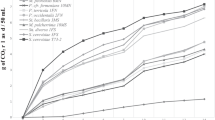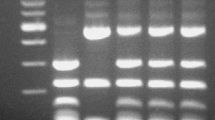Abstract
Global warming has a significant impact on different viticultural parameters, including grape maturation. An increment of photosynthetic activity generates a rapid accumulation of sugars in the berry, followed by a dehydration process which leads to a higher concentration of soluble solids. This effect is exacerbated by current viticultural practices which favor the harvest of very mature grapes to obtain wines with sweet tannins. Considering the initial hyperosmotic stress conditions and the high ethanol concentration of the produced wine, fermentation of grape musts with high sugar content could be problematic for yeast starters. In the present study, we were able to obtain by classical hybridization and spore dissection methods one hybrid and one monosporic wine yeast strain with a combined ethanol and osmotolerant phenotype. The improved yeasts were tested in vinification trials with high sugar concentration and displayed excellent fermentation performance. Importantly, the obtained wines also showed good organoleptic properties during sensory analysis. Based on our results, we believed our improved hybrid and monosporic strains can be considered good alternatives to be used as yeast starters for fermentations with high sugar content.



Similar content being viewed by others
Explore related subjects
Discover the latest articles and news from researchers in related subjects, suggested using machine learning.References
Agarbati A, Canonico L, Comitini F, Ciani M (2020) Reduction of sulphur compounds through genetic improvement of native Saccharomyces cerevisiae useful for organic and sulphite-free wine. Foods 9(5):658. https://doi.org/10.3390/foods9050658
Aponte M, Romano R, Villano C, Blaiotta G (2020) Dominance of S. cerevisiae commercial starter strains during Greco di Tufo and Aglianico wine fermentations and evaluation of oenological performances of some indigenous/residential strains. Foods 9(11):1549. https://doi.org/10.3390/foods9111549
Bernardi AM (2013) Selección de levaduras vínicas provenientes de la Provincia de Mendoza. Tesis, Universidad Nacional de Cuyo. http://bdigital.uncu.edu.ar/5049. Accessed 7 July 2022
Betlej G, Bator E, Oklejewicz B, Potocki L, Górka A, Slowik-Borowiec M, Czarny W, Domka W, Kwiatkowska A (2020) Long-term adaption to high osmotic stress as s tool for improving oenological characteristics in industrial wine yeast. Genes 11(5):576–591. https://doi.org/10.3390/genes11050576
Bonciani T, Solieri L, De Vero L, Giudici P (2016) Improved wine yeast by direct mating and selection under stressful fermentative conditions. Eur Food Res Technol 242:899–910. https://doi.org/10.1007/s00217-015-2596-6
Bonciani T, De Vero L, Mezzetti F, Fay JC, Giudici P (2018) A multi-phase approach to select new wine yeast strains with enhanced fermentative fitness and glutathione production. Appl Microbiol Biotechnol 102(5):2269–2278. https://doi.org/10.1007/s00253-018-8773-3
Boveri S, Rainier S, Pulvirenti A (2012) Method for the validation of intraspecific crosses of Saccharomyces cerevisiae strains by minisatellite analysis. Can J Microbiol 58(3):350–358. https://doi.org/10.1139/w11-142
Buescher WA, Siler CE, Morris JR, Threlfall RT, Main GL, Cone GC (2001) High alcohol wine production from grape juice concentrates. Am J Enol Vitic 52(4):345–351
Çakar ZP, Seker UOS, Tamerler C, Sonderegger M, Sauer U (2005) Evolutionary engineering of multiple-stress resistant Saccharomyces cerevisiae. FEMS Yeast Res 5(6–7):569–578. https://doi.org/10.1016/j.femsyr.2004.10.010
Caridi A, Sidari R, Solieri L, Cufari A, Giudici P (2007) Wine colour adsorption phenotype: an inheritable quantitative trait loci of yeasts. J Appl Microbiol 103(3):735–742. https://doi.org/10.1111/J.1365-2672.2007.03301.X
Chimeno SV (2015) Caracterización de un cepario de levaduras para uso enológico mediante técnicas moleculares Tesis, Universidad Nacional de Cuyo. http://bdigital.uncu.edu.ar/7236. Accessed 7 July 2022
Clavijo Almudena, Calderón Isabel L., Paneque Patricia (2011) Effect of the use of commercial Saccharomyces strains in a newly established winery in Ronda (Málaga, Spain). Antonie van Leeuwenhoek 99(3):727–731. https://doi.org/10.1007/s10482-010-9514-5
D’Alessio C, Caramelo JJ, Parodi AJ (2005) Absence of nucleoside diphosphatase activities in the yeast secretory pathway does not abolish nucleotide sugar—dependent protein glycosylation. J Biol Chem 280(49):40417–40427. https://doi.org/10.1074/jbc.M503149200
Dragosits M, Mattanovich D (2013) Adaptive laboratory evolution principles and applications for biotechnology. Microb Cell Factories 12(1):1–17. https://doi.org/10.1186/1475-2859-12-64
Donalies UE, Nguyen HT, Stahl U, Nevoigt E (2008) Improvement of Saccharomyces yeast strains used in brewing, wine making and baking. Adv Biochem Eng Biotechnol 111:67–98. https://doi.org/10.1007/10_2008_099
European Food Safety Authority (2019) Food safety in the EU. Publications Office. https://doi.org/10.2805/661752. Accessed 7 July 2022
Fleet GH (2008) Wine yeasts for the future. FEMS Yeast Res 8(7):979–995. https://doi.org/10.1111/j.1567-1364.2008.00427.x
García V, Rivera J, Contreras A, Ganga MA, Martínez C (2012) Development and characterization of hybrids from native wine yeasts. Braz J Microbiol 43(2):482–489. https://doi.org/10.1590/S1517-83822012000200008
García-Ríos E, Guillén A, de la Cerda R, Pérez-Través L, Querol A, Guillamón JM (2019) Improving the cryotolerance of wine yeast by interspecific hybridization in the genus Saccharomyces. Front Microbiol 9:3232. https://doi.org/10.3389/fmicb.2018.03232
Giudici P, Solieri L, Pulvirenti A (2005) Strategies and perspectives for genetics improvement of wine yeast. Appl Microbiol Biotechnol 66:622–628. https://doi.org/10.1007/s00253-004-1784-2
Hoffman CS, Winston FA (1987) A ten minutes preparation from yeast efficiently releases autonomous plasmids for transformation of Escherichia coli. Gene 57(2–3):267–272. https://doi.org/10.1016/0378-1119(87)90131-4
Jara C, Laurie F, Mas A, Romero J (2016) Microbial terroir in Chilean valleys: diversity of non-conventional yeast. Front Microbiol 7:663. https://doi.org/10.3389/fmicb.2016.00663
Keller M (2010) Managing grapevines to optimize fruit development in a challenging environment: a climate change primer for viticulturists. Aust J Grape Wine Res 16:56–69. https://doi.org/10.1111/j.1755-0238.2009.00077.x
Kessi-Pérez EI, Molinet J, García V, Aguilera O, Cepeda F, López ME, Sari S, Cuello R, Ciklic I, Rojo MC, Combina M, Araneda C, Martínez C (2020) Generation of a non-transgenic genetically improved yeast strain for wine production from nitrogen-deficient musts. Microorganisms 8(8):1194. https://doi.org/10.3390/microorganisms8081194
Legras JL, Karst F (2003) Optimization of Interdelta analysis for Saccharomyces cerevisiae strains characterization. FEMS Microbiol Lett 221:249–255. https://doi.org/10.1016/S0378-1097(03)00205-2
Lópes C, van Broock M, Querol A, Caballero C (2002) Saccharomyces cerevisiae wine yeast populations in a cold region in Argentinean Patagonia. a study al different fermentation scales. J Appl Microbiol 93:608–615. https://doi.org/10.1046/j.1365-2672.2002.01738.x
Lópes C, Rodríguez ME, Sangorrín M, Querol A, Caballero A (2007) Patagonian wines: the selection of an indigenous yeast starter. J Ind Microbiol Biotechnol 34(8):539–546. https://doi.org/10.1007/s10295-007-0227-3
Marsit S, Dequin S (2015) Diversity and adaptive evolution of Saccharomyces wine yeast: a review. FEMS Yeast Res 15(7):1–12. https://doi.org/10.1093/femsyr/fov067
Marullo P, Bely M, Masneuf-Pomarede I, Aigle M, Dubourdieu D (2004) Inheritable nature of enological quantitative traits is demonstrated by meiotic segregation of industrial wine yeast strains. FEMS Yeast Res 4(7):711–719. https://doi.org/10.1016/j.femsyr.2004.01.006
Marullo P, Bely M, Masneuf-Pomarede I, Pons M, Aigle M, Dubourdieu D (2006) Breeding strategies for combining fermentative qualities and reducing off-flavor production in a wine yeast model. FEMS Yeast Res 6:268–279. https://doi.org/10.1111/j.1567-1364.2006.00034.x
Mas A, Torija J, Beltrán G, Novo M, Hierro N, Poblet M, Rozés N, Guillamón J (2002) Selección de levaduras. Tecnología Del Vino Fermentos 1:39–44
Massera A, Assof M, Sturm ME, Sari S, Jofré V, Cordero-Otero R, Combina M (2012) Selection of indigenous Saccharomyces cerevisiae strains to ferment red musts at low temperature. Ann Microbiol 62(1):367–380. https://doi.org/10.1007/s13213-011-0271-0
Mira de Orduña R (2010) Climate change associated effects on grape and wine quality and production. Food Res Int 43(7):1844–1855. https://doi.org/10.1016/j.foodres.2010.05.01
Nikolau E, Soufleros E, Bouloumpasi E, Tzanetakis N (2006) Selection of indigenous Saccharomyces cerevisiae straits according to their oenological characteristics and vinifications results. Food Microbiol 23:205–211. https://doi.org/10.1016/j.fm.2005.03.004
OIV International Organisation of Vine and Wine (2015) Compendium of international methods of analysis of wines and musts. Volume 1, sections 3.1.1 sugars, 3.1.2 alcohols and 3.1.3 acids
Ortiz MJ, Barrajón N, Alves Baffi M, Arévalo-Villena M, Briones A (2013) Spontaneous must fermentation: identification and biotechnological properties of wine yeast. LWT - Food Sci Technol 50:371–377. https://doi.org/10.1016/j.lwt.2012.09.019
Pérez-Través L, Lopes C, Barrio E, Querol A (2012) Evaluation of different genetic procedures for the generation of artificial hybrids in Saccharomyces genus for winemaking. Int J Food Microbiol 156:102–111. https://doi.org/10.1016/j.ijfoodmicro.2012.03.008
Pérez Torrado R, Querol A, Guillamón M (2015) Genetic improvement of non-GMO wine yeast: Strategies, advantages and safety. Trends Food Sci Technol 45:1–11. https://doi.org/10.1016/j.tifs.2015.05.002
Rainieri S, Pretorius IS (2000) Selection and improvement of wine yeasts. Ann Microbiol 50(1):15–31
Ribéreau-Gayon P, Dubourdieu D, Doneche B, Lonvaud A (2006) Handbook of enology. The microbiology of wine and vinifications, 2nd edn. Wiley, Chichester
Roessler EB, Pangborn RM, Sidel JL, Stone H (1978) Expanded statistical tables for estimating significance in pared-preference, pair difference, duo-trio and triangle test. J Food Sci 43:940–941
Steensels J, Meersman E, Picca Nicolino M, Voordeckers K, Verstrepen K (2014) Improving industrial yeast strains: exploiting natural and artificial diversity. FEMS Microbiol Rev 38:947–995. https://doi.org/10.1111/1574-6976.12073
Su Y, Gamero A, Rodríguez ME Lópes CA, Querol A, Guillamón JM (2019) Interspecific hybridisation among diverse Saccharomyces species: a combined biotechnological solution for low-temperature and nitrogen-limited wine fermentations. Int J Food Microbiol 310:108331. https://doi.org/10.1016/j.ijfoodmicro.2019.108331
Zuzuarregui A, del Olmo M (2004) Analyses of stress resistance under laboratory conditions constitute a suitable criterion for wine yeast selection. Antonie Van Leeuwenhoek 85:271–284. https://doi.org/10.1023/b:anto.0000020162.21248.53
Acknowledgements
We thank Dr. Ariel Massera for critical reading of the manuscript.
Funding
This work was financially supported by Instituto Nacional de Tecnología Agropecuaria (INTA), Universidad Nacional de Cuyo (UNCUYO) and Corporación Vitivinícola Argentina (COVIAR).
Author information
Authors and Affiliations
Contributions
MLS participated in the design and coordination of the study, performed the experiments and interpreted the data. SVC performed the experiments and participated in data analysis. LAM and IFC conceived of the study, participated in its design and coordination, interpreted the data, and drafted the manuscript.
Corresponding author
Ethics declarations
Conflict of interest
The authors declare no conflict of interests.
Additional information
Publisher's Note
Springer Nature remains neutral with regard to jurisdictional claims in published maps and institutional affiliations.
Supplementary Information
Below is the link to the electronic supplementary material.
Rights and permissions
Springer Nature or its licensor holds exclusive rights to this article under a publishing agreement with the author(s) or other rightsholder(s); author self-archiving of the accepted manuscript version of this article is solely governed by the terms of such publishing agreement and applicable law.
About this article
Cite this article
Sánchez, M.L., Chimeno, S.V., Mercado, L.A. et al. Hybridization and spore dissection of native wine yeasts for improvement of ethanol resistance and osmotolerance. World J Microbiol Biotechnol 38, 225 (2022). https://doi.org/10.1007/s11274-022-03400-7
Received:
Accepted:
Published:
DOI: https://doi.org/10.1007/s11274-022-03400-7




